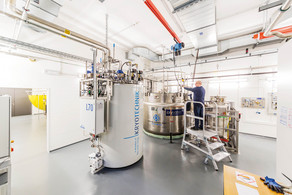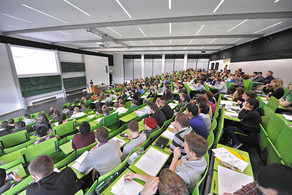Thesis defense of Lars Hoffmann
- Defense
Molecules often form hydrogen bonds with their neighbouring molecules via polar OH groups. In this work, the dynamics of hydrogen-bonded glass formers are analysed using an inorganic model system, water, and an organic model system, phenol. High- and low-density amorphous ice are studied by 17O-NMR. The line shape is analysed with the help of simulations and the dynamics encoded in the longitudinal spin relaxation are described using spectral densities. Compact and porous amorphous solid water are a further modification of amorphous ice; the influence of the pore structure on the dielectric relaxation is investigated. Furthermore, aqueous salt solutions are often used as models for supercooled water because water and amorphous ice strongly tend to crystallise. In this work, salts are tested for their suitability to perform NMR experiments on nuclei with half-integer spins subjected to a strong quadrupole interaction. All tested aqueous rubidium salt solutions tend to crystallise; a eutectic RbNO3 solution proves to be partially suited. Similar to water, phenol is difficult to supercool and the steric hindrance of the phenyl ring raises the question whether hydrogen-bonded networks exist in phenol. After dissolving phenol in propylene carbonate, phenol in an amorphous state is checked for a Debye process. By combining 17O- and 2H-NMR, dielectric spectroscopy and rheology, a dynamic range of more than twelve orders of magnitude of correlation times is covered. All experiments show evidence of a weak Debye process similar to the Debye process of monohydroxy alcohols.









